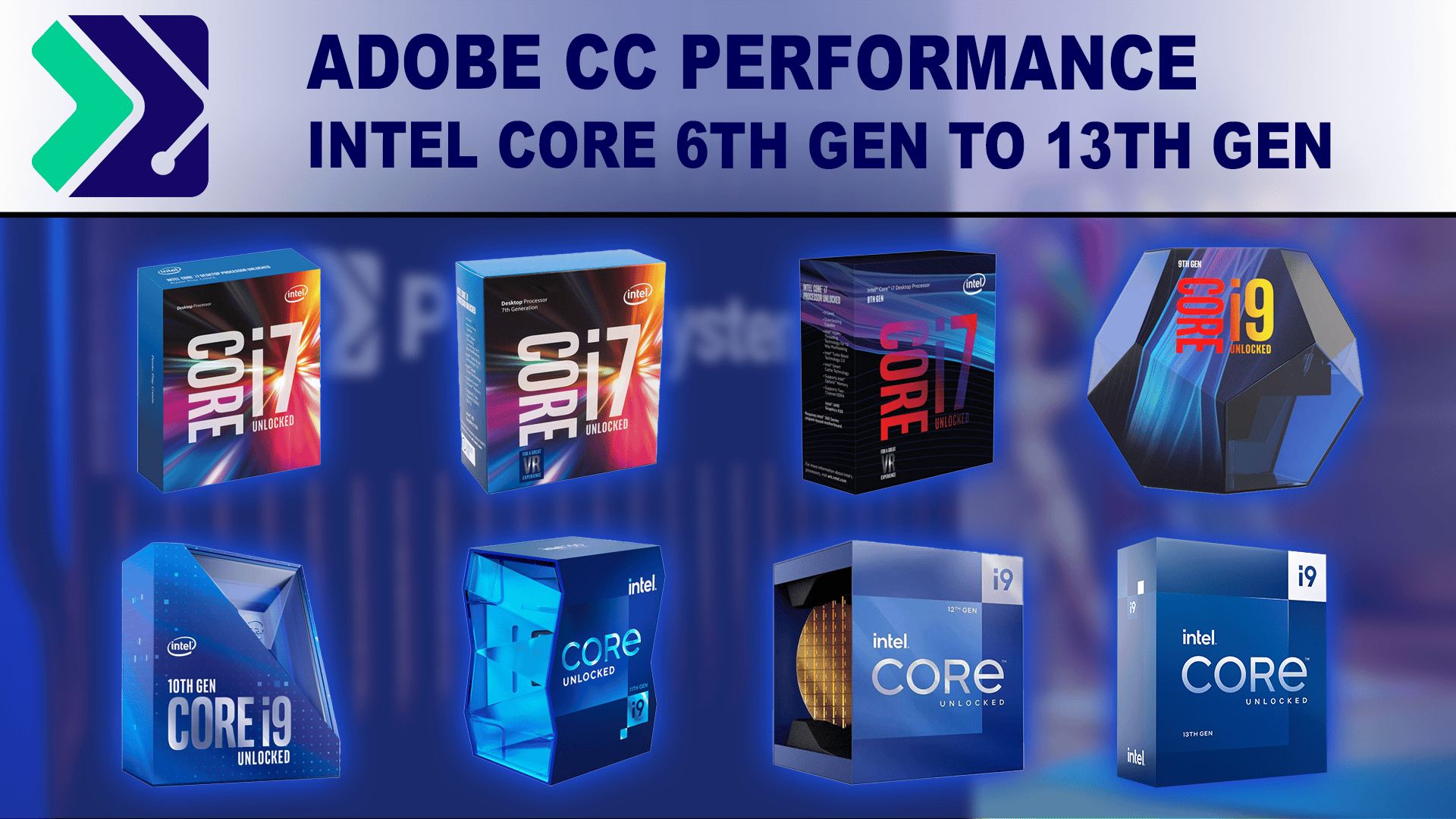Table of Contents
Introduction
Here at Puget Systems, we spend a lot of time testing and benchmarking the latest hardware from major manufacturers like Intel, AMD, and NVIDIA. However, since we usually focus on the performance of relatively new hardware, it can be difficult to appreciate just how much progress there has been over long periods of time.
Today, we want to take a step back and look at how the performance of Intel Core processors in particular has improved over the last seven years for Adobe Creative Cloud applications like Photoshop, Lightroom Classic, Premiere Pro, and After Effects. Limiting our examination to Intel Core and Adobe Creative Cloud is primarily due to the fact that the data for this article is coming almost exclusively from our public PugetBench database.
Our PugetBench database currently has just shy of 100,000 benchmark results, spanning nearly 38,000 unique hardware configurations. Public results tend to have a lot of “noise”, however, with either unusually high results (likely due to overclocking), or low results (possibly due to bad drivers, thermal throttling, or other system issues). But, with enough data points, we can combat this by taking the mean result for each of the CPUs we want to look at. This does limit us a bit in what we can confidently look at since we need to have enough data points to be able to filter out the high/low results. Due to their consistent popularity over the years, we have plenty of results for Intel Core going all the way back to the Core i7 6700K, but we simply don’t have enough results for any other family of CPU to do the same kind of analysis.
Since we are using an aggregate of public results, this does mean that the scores in this article may not line up with your own system if you happen to have one of these CPUs. We did apply some filters such as requiring Quick Sync to be enabled for the Premiere Pro results, but other aspects like GPU, RAM, and storage we left completely open. So, depending on the rest of your system, you may see results that are either higher, or lower, than what we are showing. If you want to know for sure how your own system stacks up against the latest and greatest hardware, we highly recommend downloading and running our PugetBench benchmarks yourself. They are 100% free for personal use, and the results from your own system are always going to be exponentially more relevant than any tests we, or anyone else, could run.
In total, we were able to pull reliable results for the top SKU from each generation of Intel Core CPUs, going back all the way to the Intel Core i7 6700K which launched roughly 7 years ago. Between the i7 6700K and the modern Core i9 13900K, we are able to include the i7 7700K, i7 8700K, i7 9900K, i9 10900K, i9 11900K, and i9 12900KS.
Adobe Photoshop
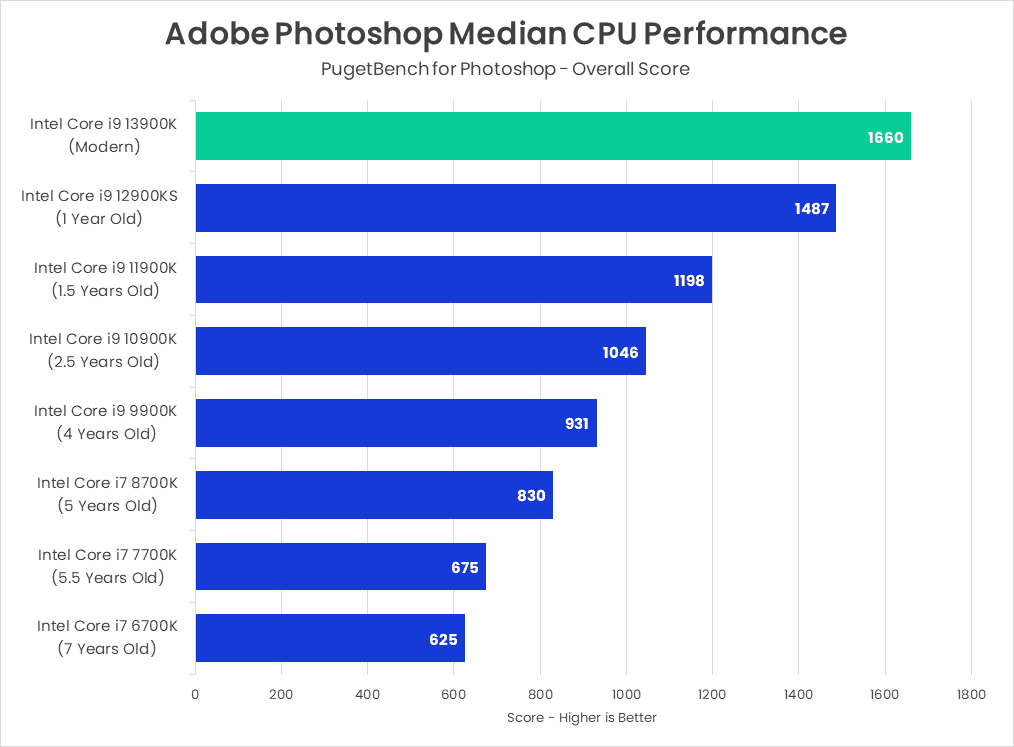
Starting off with Adobe Photoshop, we took the mean performance for each CPU for the various builds of Photoshop 2022. Over the last 7 years, Intel Core has seen a fairly steady increase in performance, with a typical gen-over-gen performance gain of about 15%. However, two CPUs had a larger-than-normal performance increase: the Intel Core i7 8700K, and the Intel Core i9 12900KS. Both of these saw closer to a 25% performance gain over the previous generation.
In terms of how much faster the latest Intel Core i9 13900K is compared to older CPUs, you have to go back about 2.5 years to the Core i9 10900K to see about a 50% increase in performance. Going back 5 years to the Core i7 8700K would net you almost exactly a 2x increase in performance, and going all the way back to the Core i7 6700K results in a 2.7x increase in performance.
Adobe Lightroom Classic
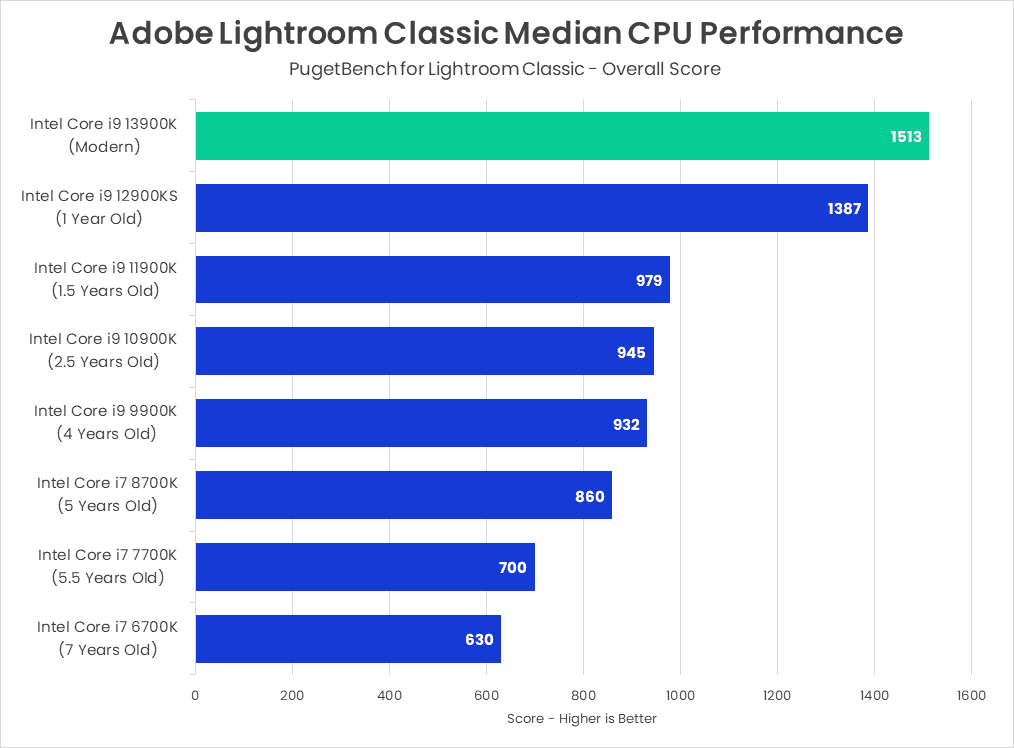
For Adobe Lightroom Classic, we are looking at the mean performance for each CPU for the various builds of Lightroom Classic 2022. The total performance gain compared to the Core i7 6700K is slightly lower than it was for Photoshop, but we are still looking at about 2.5x higher performance with a modern Core i9 13900K compared to the Core i7 6700K from 7 years ago. Once again, the Intel Core i7 8700K and the Intel Core i9 12900KS were the two CPUs that saw the biggest gen-over-gen performance gains, with the Core i9 8700K being roughly 25% faster than the Core i9 7700K, and the Core i9 12900KS coming in at a massive 47% faster than the Core i9 11900K.
In many ways, those two CPUs represent the bulk of the performance gains in recent years. Going from the Core i7 8700K all the way to the Core i9 11900K only resulted in about a 15% performance gain, and that is across 3.5 years of CPU launches. And then, suddenly, the Intel Core 12th Gen CPU family comes in and gives a massive increase in performance.
Adobe Premiere Pro
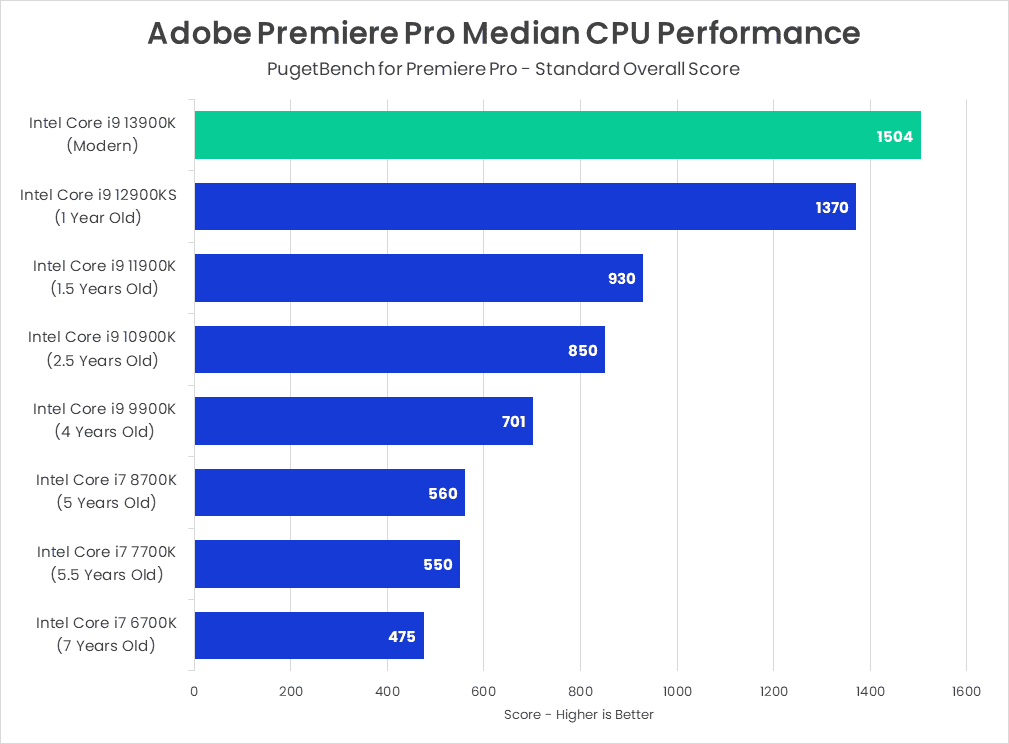
Next up is Adobe Premiere Pro, where again we limited our results to the 2022 versions of the base Adobe application. This time, compared to the Core i7 6700K, we are looking at a 3.2x increase in performance with a modern Core i9 13900K. Some of this is coming from the raw compute power of the newer CPUs, but improvements made to Quick Sync (which is used for hardware decoding/encoding of H.264 and HEVC media) are likely also contributing to the performance gains.
The biggest gains this time around come from the Core i9 12900KS, which is nearly 50% faster than the older Core i9 11900K. That is the single largest gen-over-gen performance gain we found in the course of this analysis and really demonstrates just how good that CPU (and the 12th Gen family in general) was when it launched.
This time, you only have to go back 1.5 years to the Core i9 11900K to see more than a 50% improvement in performance with the Core i9 13900K, and it only takes 4 years (with the Core i9 9900K) to see a 2x increase. And, as we noted earlier, going all the way back to the Core i7 6700K shows that the Core i9 13900K is 3.2x faster than a 7-year-old CPU.
Adobe After Effects
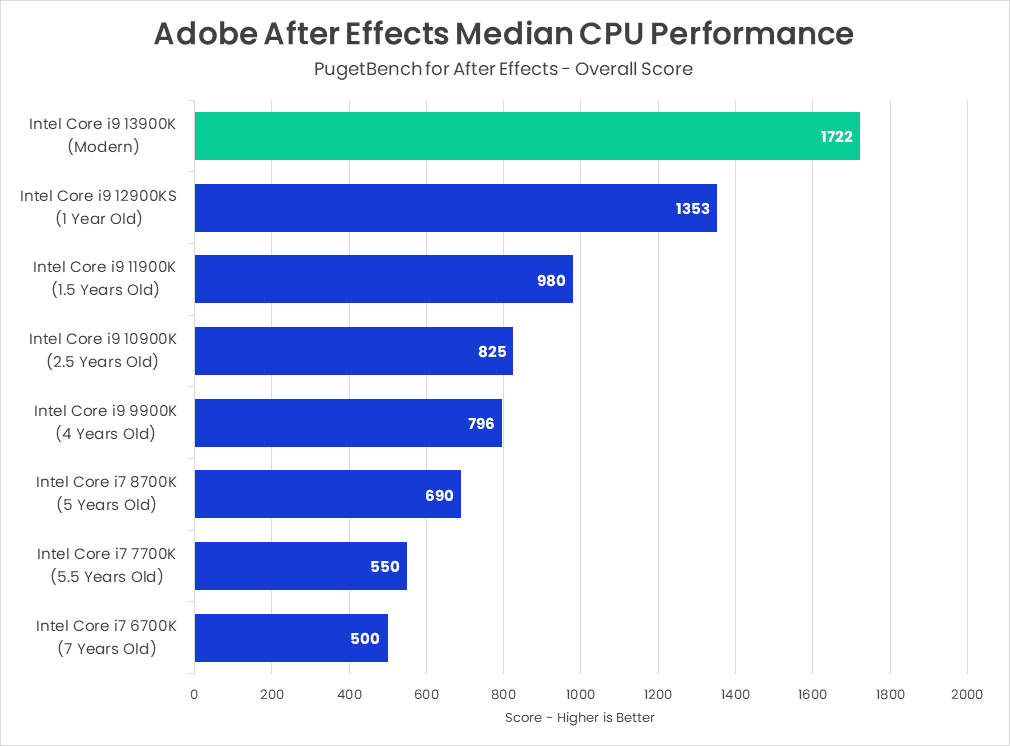
Rounding out our analysis is Adobe After Effects. These results are all with Ae 2022, which includes the recently released Multi-Frame Rendering (MFR) feature. This feature overnight gave us a massive increase in performance, as it dramatically improved how well After Effects is able to utilize multiple CPU cores for both live playback and exporting.
MFR single-handedly makes After Effects one of the best Adobe applications for higher core count CPUs, allowing the higher core counts of newer CPUs to be more beneficial than they are for Photoshop, Lightroom Classic, or Premiere Pro. For context, the Core i7 6700K was just a quad-core CPU, while the Core i9 13900K has 24 cores (8 performance cores and 16 efficiency cores).
These additional core, combined with the higher per-core performance of each generation, results in a massive 3.4x performance increase with the Core i9 13900K compared to the Core i7 6700K from 7 years ago. You only have to go back 2.5 years to the Core i9 10900K to see more than a 2x increase in performance!
Conclusion
Sometimes, it is easy to look at the fairly modest gen-over-gen performance gains we are used to seeing from new CPUs, and lose sight of how much that can add up to over time. For example, most of the Adobe applications we looked at averaged about a 15-20% gen-over-gen increase in performance, but you only have to go back 4-5 years to find that a modern Intel Core i9 13900K system would give you nearly a 2x increase in performance.
Through the years, the two most impressive CPUs from Intel are easily the Core i7 8700K and Core i9 12900KS. The i7 8700K averaged a nearly 20% gain over the previous generation i7 7700K, while the i9 12900KS averaged nearly 40% faster than the i9 11900K. The latest and greatest Core i9 13900K is certainly no slouch (averaging about 15% higher performance than the Core i9 12900KS on average), but it is hard to beat a 40% improvement.
We want to point out that this article is a bit different from our usual content. This is one of the first times we are using results from our public benchmark database, which makes it much faster to produce, and able to cover a wider range of hardware than we would typically be able to justify if we had to source and build up systems for each CPU. If you found this data interesting, let us know in the comments!
